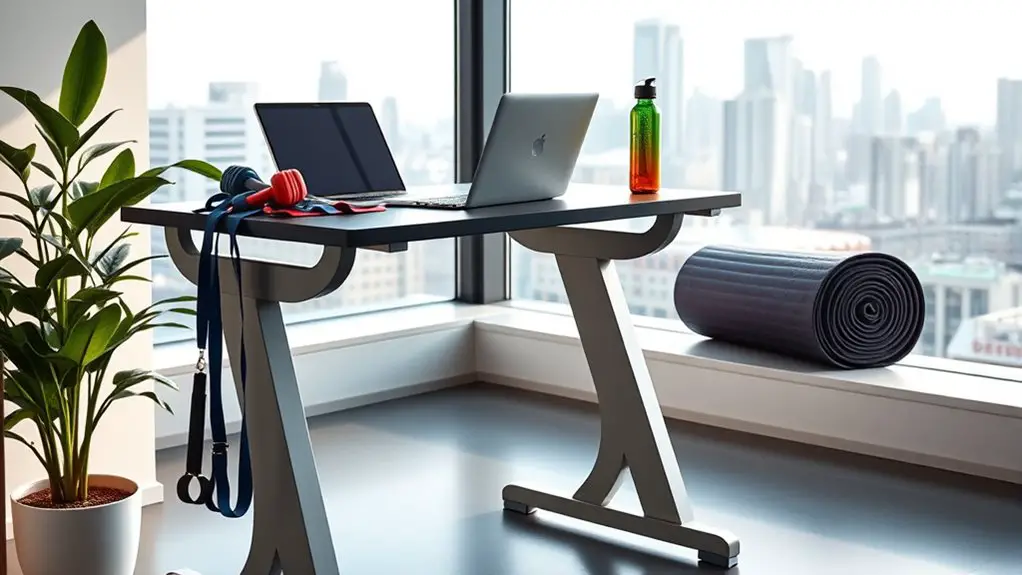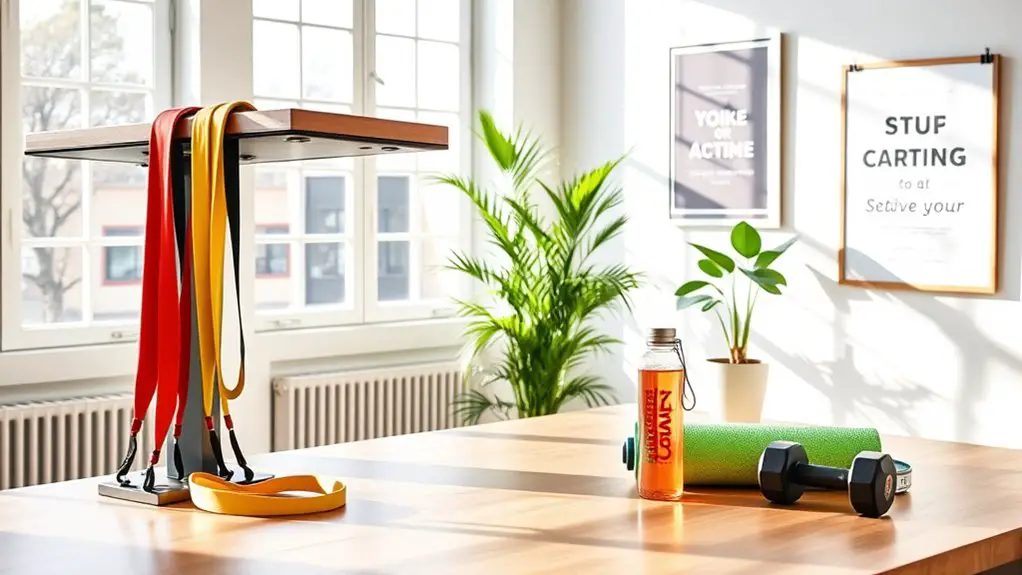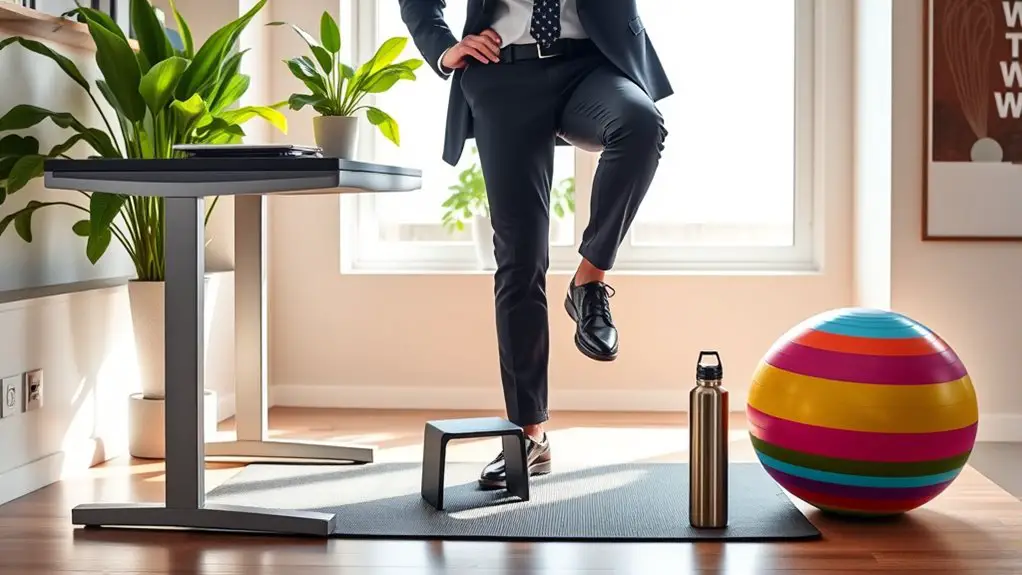How to Stay Fit With a Desk Job: Gym Solutions

Staying fit with a desk job is easier than you think! You can incorporate quick desk workouts, like seated leg lifts or chair squats, to keep your blood flowing. Don’t forget to stretch regularly to relieve tension. Utilizing office equipment creatively can also help, like using a stability ball for better core strength. Plus, staying hydrated boosts your focus. If you’re curious about more tips and creating a workplace fitness culture, there’s plenty more to explore!
The Importance of Staying Active at Work

While it might seem challenging to stay active in a desk job, incorporating movement into your workday is essential for both your physical and mental well-being. The impact of prolonged sitting can lead to various health issues, including back pain, poor circulation, and decreased energy levels. By making small adjustments, you can greatly enhance your overall health and productivity.
Taking short breaks to stand, stretch, or walk around can boost your mental clarity and focus. Even simple movements, like standing during a call or using a desk that allows for sitting and standing, can make a difference. Prioritizing activity not only helps with physical fitness but also reduces stress and improves your mood. Remember, staying active at work isn’t just about exercise; it’s about creating a healthier, more balanced work environment that supports your well-being and productivity. Incorporating activities like skipping rope can serve as an effective cardio workout that enhances your overall fitness level.
Quick Desk Workouts for Busy Professionals
Even if you’re swamped with work, you can squeeze in quick desk workouts that help you stay fit and energized throughout the day. Start with simple desk mobility exercises like seated leg lifts—extend one leg out while sitting, hold for a few seconds, then switch. This keeps your legs active and promotes circulation.
Next, try some quick cardio—stand up and do 30 seconds of high knees or jumping jacks. These bursts of activity won’t take much time but can elevate your heart rate and boost your mood.
Don’t forget to incorporate chair squats; stand in front of your chair, lower yourself as if to sit, then rise back up.
These quick desk workouts can be done between calls or tasks, making it easy to prioritize your fitness. Remember, even small movements can make a big difference in your overall health!
Incorporating Stretching Into Your Daily Routine

Incorporating stretching into your daily routine can make a big difference in how you feel at work. Consider desk-friendly exercises that you can do without leaving your chair, and think about timing those stretch breaks throughout your day. A few minutes here and there can help keep your energy up and reduce tension.
Desk-Friendly Stretching Exercises
To maintain your energy and focus throughout the workday, it’s essential to incorporate desk-friendly stretching exercises into your routine. Simple desk stretches can help alleviate tension, especially in your upper body. Start by sitting up straight, reaching your arms overhead, and gently leaning to each side for a nice side stretch. Next, roll your shoulders back and forth to loosen tight muscles. Don’t forget to stretch your neck; tilt your head to one side and hold for a few seconds. For your wrists, extend one arm in front of you and gently pull back on your fingers. These stretches can be done safely at your desk and can greatly improve your comfort and productivity throughout the day.
Timing Your Stretch Breaks
After you’ve warmed up with some desk-friendly stretches, it’s important to think about how to integrate these breaks into your daily routine. Aim for short stretch sessions lasting about 5-10 minutes, which can help alleviate tension and improve circulation. Incorporate these stretches into your workday every hour or so; this break frequency keeps your muscles engaged and reduces the risk of strain. Remember to listen to your body—if you feel tightness, take a moment to stretch. You can set reminders on your phone or use a timer to stay consistent. By timing your stretch breaks effectively, you’ll enhance your overall well-being and maintain a healthier work environment. Stay safe, and keep moving!
Utilizing Office Equipment for Fitness
When you’re stuck at your desk, you can still get a workout in by using the equipment around you. From your chair to everyday office supplies, there are plenty of creative ways to stay fit while working. Let’s explore some desk exercises, effective chair techniques, and tips for turning your office supplies into workout tools. Incorporating short bursts of skipping rope can enhance your overall fitness and boost energy levels throughout the day.
Desk Exercises Overview
While sitting at your desk for hours can feel inevitable, incorporating desk exercises into your routine is a simple way to stay active. You don’t have to leave your workspace to improve your fitness motivation and enhance your desk posture. Simple movements like seated leg lifts, shoulder rolls, and wrist stretches can keep blood flowing and reduce tension. Use your chair for support while performing gentle twists or seated marches. Even standing up to take a short break every hour can make a difference. Remember, the aim is to find exercises that fit seamlessly into your day without compromising your safety. By prioritizing these small changes, you’ll feel more energized and focused throughout your workday.
Using Chairs Effectively
Chairs aren’t just for sitting; they can also be powerful tools for enhancing your fitness routine at work. By making chair modifications, you can turn your seating into an effective fitness asset. For instance, try using a stability ball instead of a traditional office chair. This promotes balance and strengthens your core. If that’s not feasible, adjust your chair height for better posture, which can reduce strain on your back. You can also perform seated leg lifts or simple stretches while working. Remember, the key is to maintain safety—ensure your chair is stable and supportive. With these modifications, you can stay active and engaged, making the most of your desk job without sacrificing your health.
Office Supplies Workout Tips
Even if you’re stuck at your desk, you can incorporate fitness into your day by creatively using office supplies. For instance, grab a couple of paperweights for some quick paperweight lifts. Just stand with your feet shoulder-width apart, hold the weights at your sides, and lift them to shoulder height. This helps tone your arms without needing a gym.
You can also try binder squats. Place a sturdy binder at your feet, then squat down to pick it up, making sure to keep your back straight. Stand back up and repeat. These exercises keep you active and help prevent stiffness, all while you’re still at your workstation. Remember to prioritize safety to avoid any injuries!
Tips for Taking Active Breaks
Taking active breaks throughout your workday can considerably boost your energy and productivity, especially if you’re stuck at a desk for long hours. Incorporating short bursts of mindful movement can help reduce tension and improve focus.
Try these active break ideas: stand up and stretch your arms overhead, or take a quick walk around the office. If you can, do some light exercises, like seated leg lifts or desk push-ups. Even simple actions like standing while you take a phone call can make a difference.
Set a timer to remind yourself to take these breaks every hour. It’s essential to listen to your body; if you’re feeling fatigued, focus on gentle movements. Remember, the goal is to keep your body engaged while ensuring you’re safe and comfortable. With these tips, you’ll feel more energized and ready to tackle your tasks.
Setting Up a Standing Desk

Incorporating active breaks is a great way to combat the sedentary nature of desk jobs, but setting up a standing desk can further enhance your work experience. Standing desk benefits include increased energy levels, improved posture, and reduced back pain. To guarantee safety and comfort, focus on an ergonomic setup. Start by adjusting your desk height so your elbows are at a 90-degree angle when typing. Your screen should be at eye level to prevent neck strain, and your feet should be flat on the ground or on a footrest.
Consider using a mat to cushion your feet and promote better circulation. It’s also helpful to alternate between sitting and standing throughout the day, so your body stays engaged. Remember, a standing desk isn’t a cure-all, but when used correctly, it can greatly improve your overall well-being while you work.
The Role of Hydration in Workplace Fitness
While you may be focused on deadlines and tasks, don’t underestimate the importance of staying hydrated throughout your workday. Proper hydration benefits your physical and mental health, helping to improve concentration, reduce fatigue, and maintain overall well-being. When you’re at your desk for long hours, it’s easy to forget to drink enough water.
To combat this, set up water reminders on your phone or computer. You might even consider keeping a reusable water bottle nearby, making it convenient to sip throughout the day. Aim for at least eight cups of water daily, adjusting based on your activity level.
Creating a Supportive Fitness Culture at Work
Fostering a culture of fitness at work can transform your office environment, making it more dynamic and engaging. When everyone feels supported in their health goals, it encourages teamwork and camaraderie. Here are some effective ways to create that environment:
Creating a supportive fitness culture at work fosters teamwork and makes the office environment more engaging and dynamic.
- Organize fitness challenges: Create friendly competitions that encourage everyone to participate, like step challenges or workout weeks.
- Implement motivation strategies: Share progress updates and celebrate achievements, big or small, to keep spirits high.
- Promote wellness resources: Provide access to fitness classes or wellness workshops that emphasize safe practices.
Frequently Asked Questions
Can I Lose Weight With Minimal Exercise at My Desk?
Absolutely, you can lose weight with minimal exercise at your desk! Imagine Sarah, who started incorporating desk exercises like seated leg lifts and desk push-ups during her breaks. These small movements can boost calorie burning while you work. Even a few minutes of activity can make a difference over time. Just remember to focus on maintaining good posture and staying hydrated. Consistency is key, and every little bit helps!
What Are the Best Snacks for Staying Energized During Work?
When it comes to staying energized during work, healthy snacking is key. You’ll want to choose snacks that act as energy boosters without the crash. Think about grabbing nuts, yogurt, or fresh fruit—these options provide nutrients and keep you feeling satisfied. Avoid sugary snacks that can lead to quick energy spikes and subsequent drops. Staying hydrated’s also important, so don’t forget to drink water throughout the day to maintain your focus and energy levels.
How Can I Motivate Coworkers to Join Fitness Activities?
Imagine a team of superheroes, united by a common goal of fitness. To motivate your coworkers, consider organizing group challenges that promote teamwork and fun. Create fitness incentives, like rewards for achieving shared milestones, to spark enthusiasm. Emphasize the importance of safety by suggesting activities that everyone can comfortably participate in. Sharing progress and celebrating small wins will not only inspire others but also strengthen your team’s camaraderie and commitment to a healthier lifestyle.
Is It Beneficial to Use a Fitness Tracker at Work?
Using a fitness tracker at work can be really beneficial. It helps you monitor your activity levels, reminding you to take breaks and move around. These small adjustments contribute to workplace wellness, reducing stress and increasing productivity. Plus, tracking your steps and heart rate can motivate you to reach daily goals, making you feel accomplished. So, if you’re looking to stay active, a fitness tracker could be a great tool for you.
How Often Should I Change My Desk Workout Routine?
You should aim to change your desk workout routine every four to six weeks. This workout frequency helps keep your body challenged and engaged, reducing the risk of injury due to repetitive movements. Incorporating routine variation not only prevents boredom but also targets different muscle groups, promoting overall strength. Listen to your body, and don’t hesitate to adjust your routine if you feel any discomfort or strain. Staying safe while staying fit is key!





